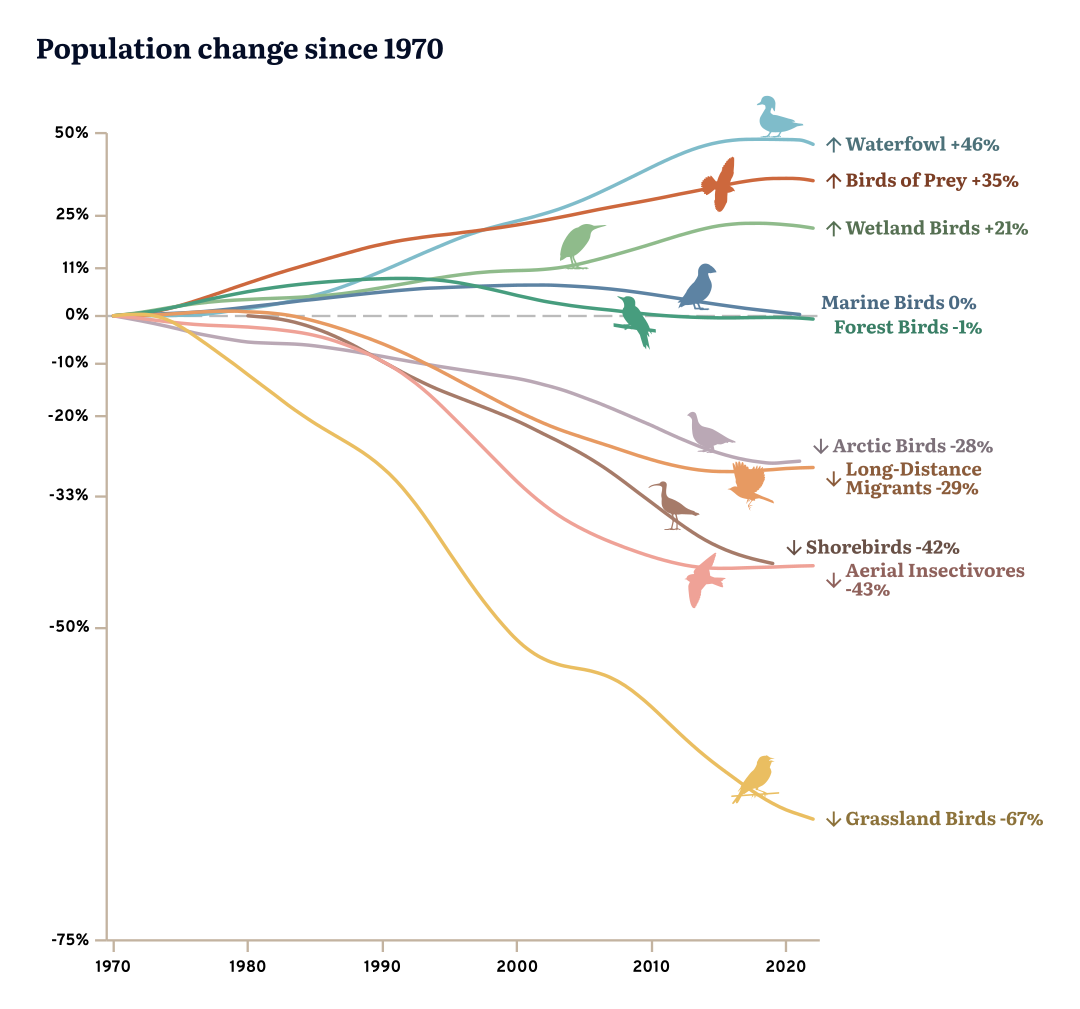Release of The State of Canada’s Birds 2024 report
Backgrounder
Developed by Environment and Climate Change Canada and Birds Canada, The State of Canada’s Birds 2024 report provides accessible, scientific insight into the population status of 463 bird species that occur regularly in Canada.
Population changes in Canada’s bird species since 1970
- 168 species (36 percent) have decreased in population
- 143 species (31 percent) have increased in population
- 98 species (21 percent) have experienced little change in population
- 54 species (12 percent) are data deficient (not enough information to determine a trend)

Long Description
A spaghetti chart showing the population change in Canada’s birds from 1970 to 2020. The graph shows Waterfowl increase by 46%, Birds of Prey increase by 35%, Wetland Birds increase by 21%, Marine Birds increase by 0%, Forest Birds decrease by 1%, Arctic Birds decrease by 28%, Long-Distance Migrants decrease by 29%, Shorebirds decrease by 42%, Aerial Insectivores decrease by 43%, and Grassland Birds decrease by 67%.
Key findings from the report
- Three bird groups have increased in population since 1970: waterfowl (46 percent), birds of prey (35 percent), and wetland birds (21 percent). From banning DDT (dichlorodiphenyltrichloroethane) to save the Peregrine Falcon campaign to conserving wetlands for birds like the Least Bittern, conservation action is having positive impacts on bird populations.
- A crisis is unfolding in the Prairies. Grassland birds have declined by 67 percent since 1970, with no sign of levelling off. The destruction and degradation of native grasslands is the single greatest threat to this group of birds and biodiversity in general. Without urgent action to conserve their habitat, species like the Chestnut-collared Longspur and the Burrowing Owl may be lost from Canada, along with the ecosystem services that healthy habitats provide.
- Shorebirds are continuing to decline, with a drop of 42 percent since 1970. The populations of some species, like the Hudsonian Godwit, have fallen by over 90 percent. Shorebirds face many threats, as many make perilous, long-distance migrations and breed in vulnerable habitats, like the Arctic and the Prairies.
- Aerial insectivores—birds that hunt for insects in flight—have declined by 43 percent since 1970. Although the decline has subsided recently, populations are far lower than they were in the 1970s. Declines in insect populations have likely been one of the major causes, and reversing these declines could help save threatened birds like the Bank Swallow and the Chimney Swift.
The threats birds face in Canada
- Habitat loss threatens birds across Canada and affects migratory birds throughout their annual journeys. The destruction and degradation of habitats is driven by agricultural practices, urban development, natural resource extraction, and infrastructure.
- Climate change is a significant and growing threat to birds in Canada. Northern birds are likely to be most affected, as the changing climate alters the timing of events like insect and plant emergence. An increase in extreme weather events like storms, floods, droughts, and wildfires also puts birds at risk.
- Outdoor and feral cats kill more than 100 million birds in Canada annually.
- Collisions with windows are estimated to kill more than 25 million birds in Canada every year, especially when migration brings many species into urban and suburban areas. Millions of birds are also killed annually through collisions with vehicles and power lines.
- Contaminants and waste affect birds in all environments. Pesticides and other contaminants from agriculture and industry threaten both birds and their habitats. Ingestion of plastics also causes mortality, especially in marine birds.
How Canadians can help protect birds
- Create and protect habitats for birds. Plant native plants, reduce pesticide use, and make windows safer for birds.
- Keep cats indoors or provide outside time with a leash or catio. Leash dogs in sensitive natural areas.
- Help fight climate change. Use less fossil fuel, waste less food, use less energy at home, and eat less meat.
- Volunteer for conservation. Take part in citizen science and support local, regional, and national organizations that work to conserve birds and their habitats. Participate in tree plantings, invasive species control, habitat creation, and restoration projects.
- Choose bird-friendly products. If you are able, choose organic produce, bird-friendly coffee, certified paper products, sustainable seafood, and grass-fed beef.
- Buy less and produce less waste. Use fewer single-use plastics, dispose of garbage and recycling properly, and help with clean-ups.
- Learn more about birds, contribute to an inclusive and accessible birding community, and advocate for bird-friendly initiatives, policies, and conservation action.
Page details
- Date modified: